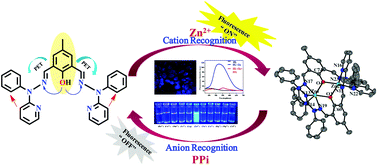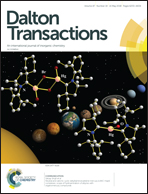Combined experimental and theoretical studies on selective sensing of zinc and pyrophosphate ions by rational design of compartmental chemosensor probe: Dual sensing behaviour via secondary recognition approach and cell imaging studies†
Abstract
A compartmental chemosensor probe HL has been designed and synthesized for the selective recognition of zinc ions over other transition metal ions via fluorescence “ON” strategy. The chemosensing behaviour of HL was demonstrated through fluorescence, absorption and NMR spectroscopic techniques. The molecular structure of the zinc complex derived from HL was determined by X-ray crystallography. A probable mechanism of this selective sensing behavior was described on the basis of spectroscopic results and theoretical studies by density functional theory (DFT). The biological applicability of the chemosensor HL was examined via cell imaging on HeLa cells. The HL-zinc complex served as a secondary fluorescent probe responding to the pyrophosphate anion specifically over other anions. The fluorescence enhancement of HL in association with Zn2+ ions was quenched in the presence of pyrophosphate (PPi). Thus, a dual response was established based on “OFF–ON–OFF” strategy for detection of both cation and anion. This phenomenon was utilized in the construction of a “INHIBIT” logic gate.



 Please wait while we load your content...
Please wait while we load your content...